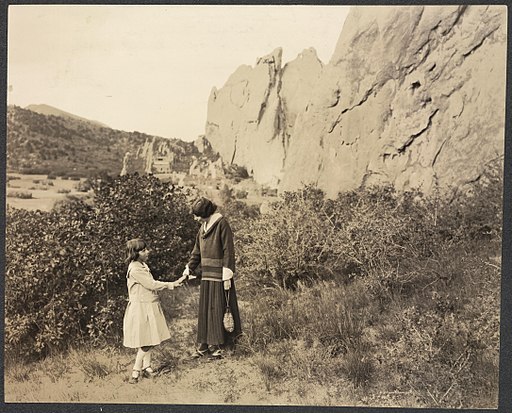Reason to Smile
It’s a fair guess that at some point in their lives most women have had someone, usually a man, but sometimes another woman, urge them to smile more, as if it were incumbent upon women to always appear pleasant and non-threatening. No one tells men to smile, except maybe for pictures. This past week, on Wednesday, May 30, Illinois became the 37th state to ratify the Equal Rights Amendment (ERA), leaving the amendment one state short of the approval by three fourths of the states required to become law. That’s reason to smile. Celebration, however, may still be a long struggle away.

Alice Paul, on the right, leader of the feminist movement in America and vice president of the Woman’s Party, meets with Mildred Bryan, youngest Colorado feminist, in the Garden of the Gods at Colorado Springs, where on September 23rd, 1925, the Party launched its western campaign for an amendment to the Constitution giving equal rights to women. Photo by H.L. Standley.
In an episode of the 1970s television show All in the Family, Archie Bunker argues with his neighbor Irene Lorenzo , played by Carroll O’Connor and Betty Garrett, about equal pay for equal work after Irene starts working at the same place as Archie. 46 years after Congress passed the ERA in 1972, the issue remains unsettled.
There has been a development since 1939 that further clouds the entire issue of a time limit on ratification, and that is the full ratification of the 27th Amendment (Congressional Pay Raises) in 1992, after a delay of 203 years since its passing by Congress in 1789. No time limit had been imposed by Congress in 1789, of course, but since it nonetheless became the law of the land after hundreds of years of languishing in the docket, it raises the question of the legality of the decision in Dillon v. Gloss and sets a precedent for proponents of the ERA to follow in seeking to overturn the expiration of its time limit in 1982. If and when a 38th state ratifies the ERA, that state most likely being Virginia, the matter will probably bounce from the courts back to Congress, where it will have to be settled politically, making the upcoming 2018 congressional midterm elections important for yet one more reason. Until then, smile when you feel like smiling, or not at all.
— Vita 


